 If you hit the wall, find yourself getting overly attached to ideas or resisting feedback it’s time to step away. Distance improves your perspective and calms your nerves. Research creativity and a couple scenarios come up over and over again. People get ideas while showering and while taking a walk.
If you hit the wall, find yourself getting overly attached to ideas or resisting feedback it’s time to step away. Distance improves your perspective and calms your nerves. Research creativity and a couple scenarios come up over and over again. People get ideas while showering and while taking a walk.
Stepping away from my computer is the one tool that I’ve used every single day for the past 20 years. I discovered this tool when I was a political cartoonist and it became an essential tool that I’ve incorporated into my workflow. It’s that valuable.
I’ll start by feeding my brain with research and then I’ll take a walk and let my mind wander. While walking I’m more likely to make connections between ideas and more freely plan my next steps. Whether I need the break or not I take a walk religiously every day in the mid-afternoon.










